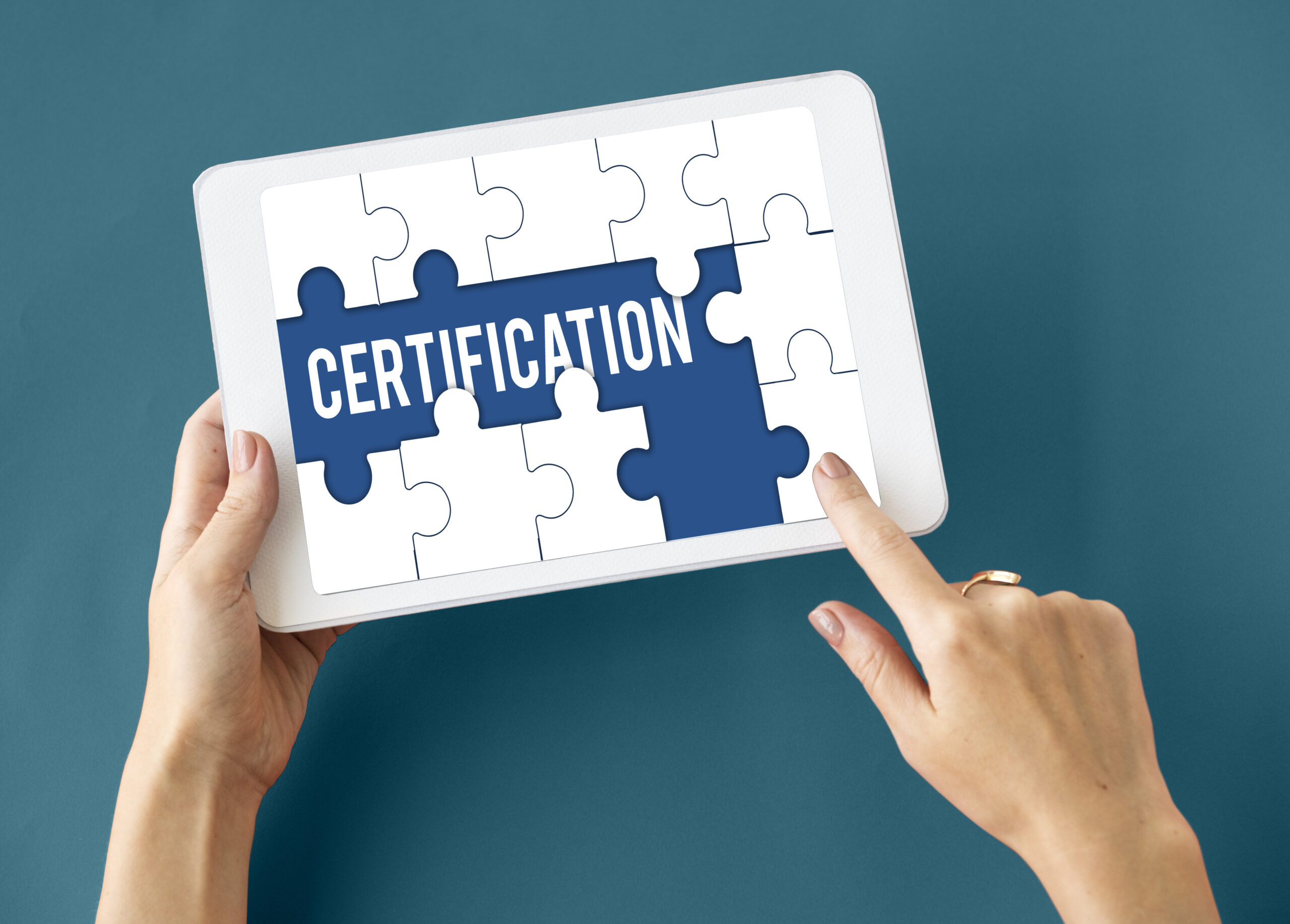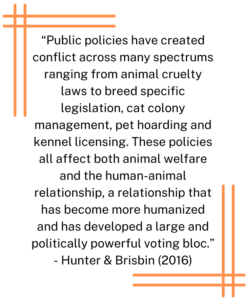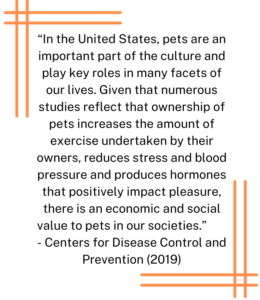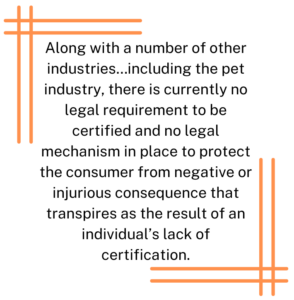Barks Blog
Pet Training and Behavior Consulting: Licensing vs. Industry Certification

This article is excerpted from the book, Pet Training and Behavior Consulting: A Model for Raising the Bar to Protect Professionals, Pets and Their People, authored by Niki J. Tudge, Susan J. Nilson, Debra A. Millikan and Louise A. Stapleton-Frappell (pp. 14-21). The book is available as a free download from DogNostics Career Center or in print from Amazon.
According to Roth and Ramlow (2016), “Americans have always been rooted in the idea of economic freedom.” In other words, Americans tend to be of the belief that hard work and determination will pay off. Children, from a young age, may be told that, rich or poor, if they have the right attitude, a good work ethic and are honest, then success will be attainable. We might, then, wonder why the practice of licensing has become so prevalent. Why does the government, through occupational licensing, place obstacles such as complex rules and barriers to the so-called American dream, especially since some of the current research we will looked at here suggests a failure to meet these goals?
More specifically, and for the purposes of this book, is there a role to play and a suitable occupational license for trainers and behavior consultants within the pet industry? We will attempt to answer this important question and, from there, provide a recommended model of best practice for the oversight of pet industry trainers.
In the United States, more than one-quarter, or 25-30% of workers, are now required to hold a license to perform their jobs. Many of these licenses are controlled and administered at a state level (Roth & Ramlow, 2016). In fact, there has been a five-fold growth in state level licensing since the early 1950s. In states such as Wisconsin, the growth of licenses and licensees has actually outpaced the population growth. Much of this change and growth can be attributed to a change in the workforce configuration toward personal and professional white collar services and away from more supervised, less empowered blue collar, low-skilled jobs.
According to the Treasury Office of Economic Policy, the Council of Economic Advisors and the Department of Labor (2015), “1,100 occupations are licensed in at least one state but fewer than 60 are licensed in all 50 states.” This reflects the priorities and motivations of individual states and their given preferences over licensing trades. South Carolina, for example, has a 12% licensed workforce whereas Iowa, at the higher end, licenses 33% of its labor force. Such differences in licensing regulations across states are not only down to differences in the types of occupations that require a license, but also to an individual state’s specific policies and licensing philosophy.
Licensing requirements across individual states and occupations also vary in terms of educational requirements and professional experience. For example, to become a security guard in Michigan, one would need to undertake three years of education and training whereas, in other states, just 11 days will suffice. Numerous examples of this type of disparity are available across many job types making it very difficult for a transient labor force to enter and compete within their given profession.
Roth and Ramlow (2016) show that there has also been a steady pace of occupational licensing reform as a result of bipartisan interest across numerous states. The reforms have fallen across two categories, those that serve no state interest and those that have little impact on health and safety. In 2015, Attorney General and Governor of Texas, Gregg Abbott, signed a bill eliminating a $200 annual licensing fee from various professions, thus impacting 600,000 workers. In 2016, Governor of Arizona Doug Doucy signed a bill eliminating licensing for citrus packers, yoga instructors and noncommercial driving instructors. And, in 2015, Governor of Rhode Island, Gina Raimondo, eliminated 27 licenses for a selection of occupations, music therapists, barbers, cosmetologists and estheticians. Overall, reforms have taken place across 12 states from 2014 to 2016.
In economics, there are two competing propositions in favor of occupational licensure: rent-seeking and public interest (Maurizi, 1974). The rent-seeking theory presents that occupational licensing limits access to certain occupations, which increases wages for those practicing and costs for those consuming (Friedman, 1962). The public interest theory argues that licensure is needed to the extent that it protects the general public from unlicensed professionals and that the end user (the client or customer) may lack the necessary knowledge or information to make an informed decision, which can, in turn, poorly impact local communities (Arrow, 1963).
Those in favor of licensing argue that its key purpose and function, when designed and implemented correctly, is to provide consumers with two main benefits: high quality services, and more structured health and safety standards. Other opinions suggest that governments license for three primary purposes:
- To generate income for the state.
- To protect public safety.
- To raise the standards of the profession.
According to Roth and Ramlow (2016), licensing also serves a fourth and often understated function: to protect members of a profession from competition and hiking up consumer prices. This speaks to the process of “grandfathering,” a system whereby all existing practitioners in an industry are automatically granted a license when new licenses are developed and rolled out. This, in some cases, occurs without a need for them to meet even the basic minimum of standards.
A report prepared by the Department of the Treasury Office of Economic Policy, the Council of Economic Advisers, and the Department of Labor (2015) suggests that occupational licensing encourages individuals to professionalize and creates career pathways incorporating education and skill training requirements. However, a review of the literature and research in the same report shows, in fact, that the opposite may occur, and that occupational licensing may:
- Increase barriers for entry into an industry.
- Increase small business overheads through licensing fees.
- Reduce employment opportunities.
- Increase service pricing for consumers, varying from 3-16%.
- Not significantly improve the level of service quality.
- Create a 10-15% disparity in earnings between licensed and unlicensed workers with similar education, experience, and training.
- Accelerate a decline in innovation and research.
- Restrict worker mobility across states.
The Process of Licensing
As already stated, occupational licensing is a form of government regulation that requires individuals wanting to practice their trade to obtain permission from a government body. According to Kleiner (2017), it is “the process by which governments establish qualifications required to practice a trade or profession, so that only licensed practitioners are allowed by law to receive pay for doing work in the occupation.” However, all too often, licensing is converged with or misrepresented as credentialing when, in reality, the two are very different. The argument also exists that it is not the role of an individual or institute to provide oversight for an industry or specific areas of an occupation where one is not an expert. For dog trainers, who form part of those Other Services we discussed in the Executive Summary, one way of taking control of their destiny would be to establish a standard level of education. Dunbar (qtd. in Hubbard Sorlie, 2018) suggests “a degree-level course that is more practical than any other type of training course being offered, and everyone has to have it…It needs to be offered worldwide, translated into Spanish, Japanese and other languages. This would be the gold standard in education…otherwise another profession will do it, or heaven forbid, the government.”
The process of licensing whereby one is granted permission by state or federal governments to practice a particular occupation or profession legitimizes all practitioners who are either grandfathered into a new licensing tenure or meet the minimal requirement guidelines by the government oversight body. This is, more often than not, a body of individuals who are versed in government policy, but not necessarily in the required competencies of the skilled licensed holder. In Maryland alone, the Division of Occupational and Professional Licensing oversees 21 licensing boards, commissions and programs appointed by the Governor. The Division is responsible for regulating the activities of more than 246,000 individuals and businesses across 25 professions (Maryland Government, 2018).
As the licensing process involves the power of the state, should a practitioner violate the licensing terms, they can be held legally accountable under civil or criminal law of the governing body. In few industries, however, do the minimal educational and or skill requirements really speak to competency of the practitioner and fewer, in reality, protect the consumer from unethical or dangerous practices. Recent political trends are seeing a bipartisan interest in licensing reform, with real efforts being made to remove licensing requirements from occupations where it is deemed unnecessary. As Roth and Ramlow (2016) state, it is licensing that serves no state interest, has little impact on health and safety and only serves to fence out opportunity, that is in need of reform.
Meanwhile, politics and pets seem to be irrevocably connected. The lives of our pets are significantly impacted by politics through ownership regulation, public policy, and criminal and regulatory law enforcement.
Pets and Their Influence on Our Culture
In the United States, pets are an important part of the culture and play key roles in many facets of people’s lives. Given the number of studies reflecting that ownership of pets increases the amount of exercise undertaken by their owners, reduces stress and blood pressure, and produces hormones that positively impact pleasure, there is an economic and social value to pets in our societies (Centers for Disease Control and Prevention, 2019). In children, pet ownership has been shown to reduce allergies and assist with development. And let us not forget or underestimate the many functions pets serve and perform for the sick, disabled, and those in need of assistance (Hunter & Brisbin, 2016).
Thus, with increasing numbers of animal welfare organizations and groups now demanding political action to protect the physical, emotional and environmental well-being of pets, coupled with the fact that pets can generate costs to public health and welfare through rescue, sheltering, cleanup and care, we are beginning to see movements at a state level regarding the licensing of professionals who work with pets.
Industry Certification
The process to become certified in any given field can be more rigorous than becoming licensed. However, certifications are generally nongovernmental. They are usually earned from academic or professional societies or institutions and often have renewal terms and conditions attached to them.
Certifications recognize individuals for meeting specific criteria of skills and knowledge. They are a way for practitioners to seek self-promotion and differentiate themselves from their competitive set. Certifying organizations set standards of competency and their certification programs are designed to use these predetermined competencies as benchmarks for pass or failure performances. Consumers draw inference from certifications that a professional has met a specific standard of competency and/or carries a particular body or depth of pertinent knowledge. Along with a number of other industries, however, including the pet industry, there is currently no legal requirement to be certified and no legal mechanism in place to protect the consumer from negative or injurious consequence that transpires as the result of an individual’s lack of certification.
In such cases, the only line of recourse a consumer may take regarding a professional who advertises a specific credential is through the credential provider and the possibility of a credential recall or removal from the credentialing organization. Remember, credentialing is a declaration that the individual has successfully completed the course of study, passed an examination, or in some other manner displayed that they can meet the credentialing criteria.
It is not uncommon for a government body to decree that licensed professionals must be certified to a minimum standard to retain their licensing status, but this, in turn, begs questions about what types of credential are available and what the ethics and integrity of the approved credentialing body are.
Wilson (2016) summarizes the difference between licensing and certification thus: licensing presumes the activity is forbidden whereas certification presumes the activity is permitted by right. Licensing increases the power of government whereas certification empowers the consumer and not the government.
To delve deeper, there are certificates and there are certifications. Certificates are often issued from a narrow scope of subject matter. There are fewer tangible criteria for achieving a certificate and sometimes just participating in an educational program will deem an individual to be eligible. With industry certifications, some are administered and issued in the best interest of the credentialing organization while others take into consideration the interests of the professional, the consumer, and the industry as a whole.
It is all too common for credentials to be issued based on little objectivity and less ethical guidelines. This, as opposed to development by teams of subject matter experts who determine Job Task Analysis and a review of relevant literature to determine the required minimum standards of competency and what constitutes the required job task skills and knowledge. When the latter occurs, it is often by professional credentialing bodies who are guided by strong professional ethics and a recourse and accountability system for professionals who stray from agreed and approved operating standards.
Summary
Licensing as a regulation may be best suited to industries and trades where there is a need to protect the physical and emotional interests of an individual or sentient being and where practitioners can impact the safety and health of the consumer and their best interests. No sound minded individual would entertain medical advice or surgery from an unlicensed doctor. The licensing discussed here speaks to a level of competency and guarantees a minimum level of education and skills supported by ethical guidelines.
In industries such as the pet industry, where quality impacts public safety and protects against dangerous practitioners, there may be room for a model that provides the necessary competency and operational guidelines as well as a level of oversight and ethical supervision for trainers and behavior consultants while protecting the needs of pets and their owners and providing for transparency and consumer protection.
Bibliography
Arrow, K. (1963). Uncertainty and the Welfare Economics of Medical Care. American Economic Review 53: 941-9. Retrieved December 29, 2018, from https://web.stanford.edu/~jay/health_class/Readings/Lecture01/arrow.pdf
Centers for Disease Control and Prevention. (2019). About Pets and People. Retrieved December 29, 2018, from https://www.cdc.gov/healthypets/health-benefits/index.html
Friedman, M. (1962). Capitalism and Freedom. Chicago, IL: University of Chicago Press
Hubbard Sorlie, D. (2018, Fall). APDT Founder urges trainers to take control of their profession. APDT Chronicle of the Dog 27-31
Hunter, S., & Brisbin, R.A. (2016). Pet Politics. West Lafayette, IN: Purdue University Press
Kleiner, M.M. (2017). The influence of occupational licensing and regulation. IZA World of Labor 2017: 392. Retrieved December 29, 2018, from https://wol.iza.org/uploads/articles/392/pdfs/the-influence-of-occupational-licensing-and-regulation.pdf
Maryland Government. (2018). Department of Labor, Licensing and Regulation. Retrieved November 6, 2018, from https://www.dllr.state.md.us/license
Maurizi, A. (1974). Occupational Licensing and the Public Interest. Journal of Political Economy 82: 399-413. Retrieved December 28, 2018, from https://www.jstor.org/stable/pdf/1831186.pdf
Roth, C., & Ramlow, E. (2016). Fencing out opportunity: Occupational licensing in the Badger State. Milwaukee, WI: Wisconsin Institute for Law and Liberty. Retrieved December 28, 2018, from http://www.will-law.org/wp-content/uploads/2016/11/Licensure-FINAL.pdf
Treasury Office of Economic Policy, the Council of Economic Advisors and the Department of Labor. (2015). Occupational Licensing – A framework for policy makers. Retrieved December 28, 2018, from https://obamawhitehouse.archives.gov/sites/default/files/docs/licensing_report_final_nonembargo.pdf
Wilson, L. (2016). Legal Guidelines for Unlicensed Practitioners. (n.p.): L.D. Wilson Consultants, Inc.




